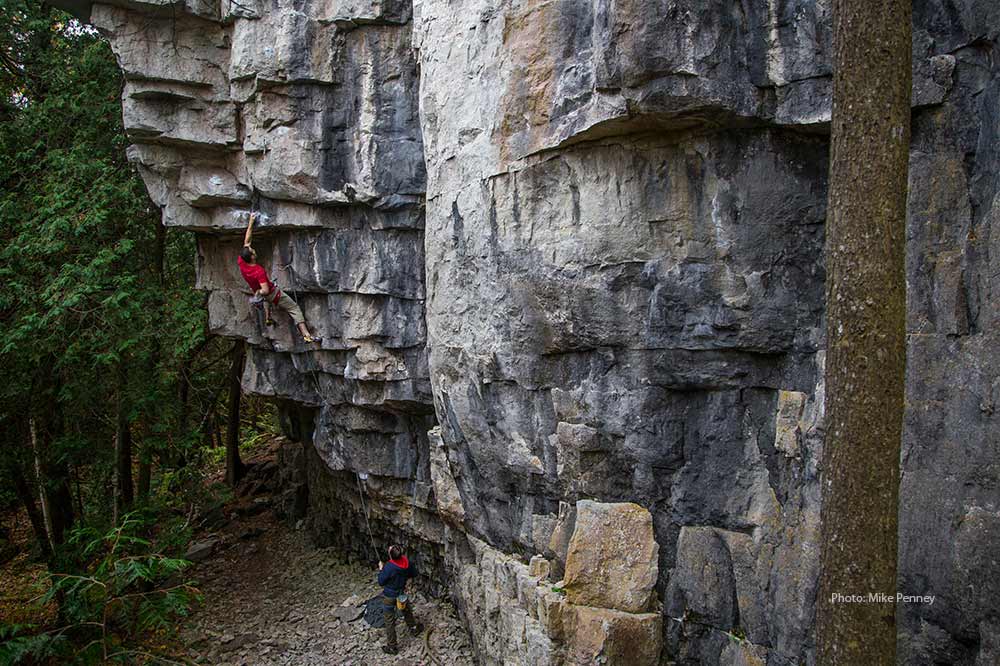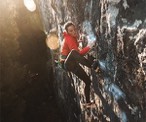Climbing Is Not A Crime
Ontario is home to Canada’s most dense and fastest growing climbing community yet we continue to be treated like second class citizens when it comes to outdoor spaces.
-

Dennis Barnes enjoying the powerful moves on Prowject 5.13a at Devil's Glen. Photo: Mike Penney
Watching climbing in the Olympics was pretty cool. I was able to set aside my frustrations with the format and simply appreciate the hard work each athlete put in for a chance at some Olympic hardware. But, as enjoyable as it was to watch, I haven’t been able to shake some negative thoughts.
Canada sent two Olympians to the 2020 games (who would want to redo all that signage, right?). As soon as the Canadians qualified, their faces popped up on everything from billboards for a national grocery chain to international makeup ads. The cultural (and corporate) acceptance for climbing in Canada has visibly and tangibly grown over the past three years.
On the eve of climbing’s Olympic debut, one park even decided to enforce a ban of climbing as a “non-conforming activity” despite tolerating climbing in that very same park over the last 30 years.
Despite climbing’s Olympic debut, the acceptance of the sport here in Ontario seems to be stuck indoors. Ontario is home to Canada’s most dense and fastest growing climbing community yet we continue to be treated like second class citizens when it comes to outdoor spaces. It’s hard to swallow the cognitive dissonance. On one hand, my non-climbing friends and family tell me how inspiring it was to watch climbers in the Olympics. On the other hand, climbers are facing some of the toughest resistance in outdoor spaces across the province.
On the eve of climbing’s Olympic debut, one park even decided to enforce a ban of climbing as a “non-conforming activity” despite tolerating climbing in that very same park over the last 30 years. One day before climbing was celebrated on the world’s most prestigious stage for athletics, park rangers intercepted climbers at an Ontario cliff and threatened to issue tickets to those that didn’t evacuate the area. In other parts of the province, climbers quietly and safely enjoying one of Ontario’s most renowned areas for elite outdoor athletes have been told they are not welcome. Meanwhile, swarms of visitors flood the opposite end of that same park leaving trails of Tim’s cups and water bottles behind.
Park managers insist climbing is a liability, despite having zero climbing deaths at any Ontario crag in the 20 or so years since I started climbing.
Park managers insist climbing is a liability, despite having zero climbing deaths at any Ontario crag in the 20 or so years since I started climbing. The same land managers banning climbers have launched a lifejacket lending program in hopes of combating an increase in drownings across their properties but continue to allow swimming in their parks. It’s impossible to understand the logic. According to an OAC (Ontario Alliance of Climbers) survey, a climber is 10x more likely to rescue an injured hiker than to be injured themselves. But we constantly battle these “liability” concerns based on false perceptions of our sport that have no base in reality.
Feeling frustrated? Me too, but it’s not all bad news. A handful of forward-thinking private and public land managers have been incredibly open to learning from and working with rock climbers. They have come to trust our expertise and have adapted their land management policies to create a framework for sustainable climbing in their parks. As they get to know us, they see us as their feet on the ground at a time when their staff are under more strain than ever before. Even with our bad apples, climbers are overwhelmingly considered great park ambassadors by every land manager that has opted to work with our community rather than alienate us.
...we’ll have no crags left to climb if the policies that govern outdoor spaces don’t start changing.
With all of this in mind, I watched the Olympics. I imagined a wave of new climbers heading to their local gym. There’s no question it’s great for the overall climbing industry - which has suffered immensely throughout the COVID pandemic. But, when that wave of new climbers ripples into the outdoors, we’ll have no crags left to climb if the policies that govern outdoor spaces don’t start changing.
With the Olympic games behind us, I hope this acceptance will seep into the legislation and policies that govern our public lands. I want to be hopeful that our presence in the Olympics will inspire public servants to recognize rock climbers as legitimate citizens but, for now, I have my doubts.
Join the discussion of this and other climbing related stories at www.ontarioclimbing.com/forum/


